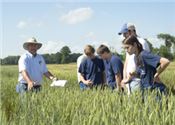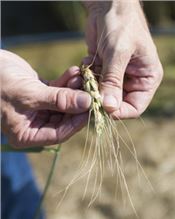|
Wheat Acreage Affected By Diseases, Weather
WINNSBORO, LA.
Poor prices, weather and diseases have caused Louisiana wheat production to drop to 16,000 acres, LSU AgCenter experts said at a field day held at the Macon Ridge Research Station.
Statewide wheat acreage was about 150,000 just three years ago, according to the 2014 AgCenter Ag Summary.
Fusarium head blight, a fungal disease of wheat also known as scab, has been a big problem in Louisiana and is a main reason why acreage is down, said AgCenter plant pathologist Trey Price.
“It’s been a devastating disease for the state, and this is the third year in a row that it has just killed us,” he said.
Available fungicides are only marginally effective on scab, Price said, and timing applications can be tricky. The fungicides cannot be applied properly when it is raining because the fungus likes warm, wet conditions.
Two other diseases, stripe rust and leaf rust, have shown up in recent weeks and caused additional problems.
“Producers have had their backs against the wall,” said AgCenter wheat specialist Boyd Padgett.
However, wheat remains a good fit for a farm rotation system, and producers can benefit from the additional income generated in early summer when operating costs are up, said AgCenter wheat and oat breeder Steve Harrison.
“Fusarium is a big problem. Stripe rust has been a problem. And growers have faced a lot of other issues,” Harrison said. “But there are new varieties coming that will help solve some of those issues.”
At the field day, Harrison reviewed plots of several early, normal and late-maturity varieties that were tested primarily for grain yields and disease resistance.
AgCenter agronomist Rick Mascagni noted that of the previous three years, 2017 has had the fewest cool nights.
“There are a number of very late varieties that were fully headed, so they didn’t require a lot of cold but require a longer photoperiod than some of the others and are adaptive to warm winters like the one we just experienced,” Harrison said.
“As climate becomes more variable, we need to find is the right balance,” he added. “If we can find that kind of control, then we will have something that is well adapted.”
AgCenter weed scientist Josh Copes said some growers who rely on the herbicide clethodim to kill ryegrass are now seeing control issues. Applying a residual herbicide in the fall followed by a spring post-emergence herbicide may be necessary to get complete control, he said, adding that incorporating more modes of action also helps prevent herbicide resistance.
AgCenter entomologist Sebe Brown said controlling transmission of the barley yellow dwarf virus goes along with controlling aphid populations, which can limit wheat yields. Seed treatments are the most effective control measure against aphids, he said.
Heavier-than-usual Hessian fly infestations have been reported across the state, too.
“It doesn’t take many Hessian flies to cause significant injury in wheat, and once the larvae bore inside the stem, it will be protected from anything you can use against it,” he said.
Producers must time foliar insecticide applications carefully. “If you catch Hessian fly adults laying eggs, typically two to three days later they are going to hatch and the larvae will burrow into the stalk,” Brown said.
AgCenter soil microbiologist Lisa Fultz told about her study of nitrogen levels in soil that had been planted with cover crops versus being left fallow. She said corn yields in her cover crop plots are doing as well as or better than the fallow ground plots.
“Our hope is that we can recapture some of that nitrogen and reduce what farmers are putting into the field early-season,” Fultz said.
The use of cover crops has increased in the past few years in the northeast part of the state, saidDonnie Miller, Macon Ridge Research Station coordinator. He said it’s important to study cover crops and other ways to help wheat producers maintain profits, especially with the statewide decrease in acreage.
Rogers Leonard, AgCenter associate vice president for plant and soil sciences, said the field day demonstrates the AgCenter’s commitment to the production of wheat, which he described as one of Louisiana’s signature crops.
Aaron Beaubouef, Natchitoches Central High School agriculture teacher, attended the field day with his agronomy team to help them prepare for state and national FFA competitions.
“Coming to these field days has helped us stay on top of new technologies, so when we went to nationals, nothing they threw at us was new,” he said.
Team member Bradley Scott said seeing real-life applications helped the team take first place at the national contest this year, which is the first time in 86 years of competitions a Louisiana team has won. ∆

Students from Natchitoches Central High School and their teacher, Aaron Beaubouef, second from right, listen as LSU AgCenter wheat and oat breeder
Steve Harrison, left, talks about a test plot at the annual wheat and oat field day held at the Macon Ridge Research Station in Winnsboro. Beauboeuf
said he brought the students to the field day so they could see crops on the research farm and hear researchers talk about their work.
The students were preparing for a national FFA competition.

A head of wheat infected with the fusarium head blight, or scab, disease displays kernels with a
bleached, slightly pink hue.
Photo by Olivia McClure/LSU AgCenter

LSU AgCenter plant pathologist Trey Price speaks at the annual wheat and oat field day held at the
Macon Ridge Research Station in Winnsboro.
Photos by Olivia McClure/LSU AgCenter
|
|